2D-GaN/AlN Multiple Quantum Disks/Quantum Well Heterostructures for High-Power Electron-Beam Pumped UVC Emitters
Abstract
:1. Introduction
2. Samples and Characterization Methods
3. Results and Discussion
3.1. Growth Kinetics of GaN/AlN MQW Structures
3.2. Stress Evolution during the Growth of GaN/AlN MQWs
3.3. Structural Properties of GaN/AlN MQWs Structures
3.3.1. Surface Topographies of MQW Structures
3.3.2. Studies of GaN/AlN MQW Structures Using X-ray Diffraction (XRD) and Reflectometry (XRR)
3.3.3. HAADF STEM Study of the GaN/AlN MQW Structure
3.4. Studies of the Optical Properties of GaN/AlN MQW Structures
3.4.1. Photoluminescence Spectra
3.4.2. Cathodoluminescence (CL) Spectra
4. Conclusions
Supplementary Materials
Author Contributions
Funding
Data Availability Statement
Conflicts of Interest
References
- Raeiszadeh, M.; Adeli, B. A Critical Review on Ultraviolet Disinfection Systems against COVID-19 Outbreak: Applicability, Validation, and Safety Considerations. ACS Photonics 2020, 7, 2941–2951. [Google Scholar] [CrossRef]
- Welch, D.; Buonanno, M.; Grilj, V.; Shuryak, I.; Crickmore, C.; Bigelow, A.W.; Randers-Pehrson, G.; Johnson, G.W.; Brenner, D.J. Far-UVC light: A new tool to control the spread of airborne-mediated microbial diseases. Sci. Rep. 2018, 8, 2752. [Google Scholar] [CrossRef] [Green Version]
- Zollner, C.J.; DenBaars, S.P.; Speck, J.S.; Nakamura, S. Germicidal ultraviolet LEDs: A review of applications and semiconductor technologies. Semicond. Sci. Technol. 2021, 36, 123001. [Google Scholar] [CrossRef]
- Amano, H.; Collazo, R.; Santi, C.D.; Einfeldt, S.; Funato, M.; Glaab, J.; Hagedorn, S.; Hirano, A.; Hirayama, H.; Ishii, R.; et al. The 2020 UV emitter roadmap. Phys. D Appl. Phys. 2020, 53, 503001. [Google Scholar] [CrossRef]
- Hsu, T.C.; Teng, Y.T.; Yeh, Y.W.; Fan, X.; Chu, K.H.; Lin, S.H.; Yeh, K.K.; Lee, P.T.; Lin, Y.; Chen, Z.; et al. Perspectives on UVC LED: Its progress and application. Photonics 2021, 8, 196. [Google Scholar] [CrossRef]
- Mondal, R.K.; Adhikari, S.; Chatterjee, V.; Pal, S. Recent adavences and challenges in AlGaN-based ultra-violet light emitting diode technologies. Mater. Res. Bull. 2021, 140, 111258. [Google Scholar] [CrossRef]
- Inoue, S.-I.; Tamari, N.; Taniguchi, M. 150 mW deep-ultraviolet light-emitting diodes with large-area AlN nanophotonic light extraction structure emitting at 265 nm. Appl. Phys. Lett. 2017, 110, 141106. [Google Scholar] [CrossRef] [Green Version]
- Mehnke, F.; Kuhn, C.; Guttmann, M.; Sulmoni, L.; Montag, V.; Glaab, J.; Wernicke, T.; Kneissl, M. Electrical and optical characteristics of highly transparent MOVPE-grown AlGaN-based tunnel heterojunction LEDs emitting at 232 nm. Photonics Res. 2021, 9, 1117–1123. [Google Scholar] [CrossRef]
- Shimahara, Y.; Miyake, H.; Hiramatsu, K.; Fukuyo, F.; Okada, T.; Takaoka, H.; Yoshida, H. Fabrication of Deep-Ultraviolet-Light-Source Tube Using Si-Doped AlGaN. Appl. Phys. Express 2011, 4, 042103. [Google Scholar] [CrossRef]
- Matsumoto, T.; Iwayama, S.; Saito, T.; Kawakami, Y.; Kubo, F.; Amano, H. Handheld deep ultraviolet emission device based on aluminum nitride quantum wells and graphene nanoneedle field emitters. Opt. Express 2012, 20, 24320–24329. [Google Scholar] [CrossRef]
- Fukuyo, F.; Ochiai, S.; Miyake, H.; Hiramatsu, K.; Yoshida, H.; Kobayashi, Y. Growth and Characterization of AlGaN Multiple Quantum Wells for Electron-Beam Target for Deep-Ultraviolet Light Sources. Jpn. J. Appl. Phys. 2013, 52, 01AF03. [Google Scholar] [CrossRef]
- Ivanov, S.V.; Jmerik, V.N.; Nechaev, D.V.; Kozlovsky, V.I.; Tiberi, M.D. E-beam pumped mid-UV sources based on MBE-grown AlGaN MQW. Phys. Status Solidi A 2015, 212, 1011–1016. [Google Scholar] [CrossRef]
- Tabataba-Vakili, F.; Wunderer, T.; Kneissl, M.; Yang, Z.; Teepe, M.; Batres, M.; Feneberg, M.; Vancil, B.; Johnson, N.M. Dominance of radiative recombination from electron-beam-pumped deep-UV AlGaN multi-quantum-well heterostructures. Appl. Phys. Lett. 2016, 109, 181105. [Google Scholar] [CrossRef]
- Li, D.; Jiang, K.; Sun, X.; Guo, C. AlGaN photonics: Recent advances in materials and ultraviolet devices. Adv. Opt. Photonics 2018, 10, 43–110. [Google Scholar] [CrossRef]
- Yoo, S.T.; So, B.; Lee, H.I.; Nam, O.; Park, K.C. Large area deep ultraviolet light of Al0.47Ga0.53N/Al0.56Ga0.44N multi quantum well with carbon nanotube electron beam pumping. AIP Adv. 2019, 9, 075104. [Google Scholar] [CrossRef] [Green Version]
- Tawfik, W.Z.; Kumar, C.M.-M.; Park, J.; Shim, S.K.; Lee, H.; Lee, J.; Han, J.H.; Ryu, S.; Lee, N.; Lee, J.K. Cathodoluminescence of 2-inch Ultraviolet-Light-Source Tube Based on the Integration of AlGaN Materials and Carbon Nanotubes Field Emitters. J. Mater. Chem. C 2019, 7, 11540–11548. [Google Scholar] [CrossRef]
- Dimkou, I.; Harikumar, A.; Donatini, F.; Lähnemann, J.; den Hertog, M.I.; Bougerol, C.; Bellet-Amalric, E.; Mollard, N.; Ajay, A.; Ledoux, G.; et al. Assessment of AlGaN/AlN superlattices on GaN nanowires as active region of electron pumped ultraviolet sources. Nanotechnology 2020, 31, 204001. [Google Scholar] [CrossRef] [Green Version]
- Bernardini, F.; Fiorentini, V.; Vanderbilt, D. Spontaneous polarization and piezoelectric constants of III-V nitrides. Phys. Rev. B 1997, 56, R10024. [Google Scholar] [CrossRef] [Green Version]
- Guo, Q.; Kirste, R.; Mita, S.; Tweedie, J.; Reddy, P.; Washiyama, S.; Breckenridge, M.H.; Collazo, R.; Sitar, Z. The polarization field in Al-rich AlGaN multiple quantum wells. Jpn. J. Appl. Phys. 2019, 58, SCCC10. [Google Scholar] [CrossRef]
- Nam, K.B.; Li, J.; Nakarmi, M.L.; Lin, J.Y.; Jiang, H.X. Unique optical properties of AlGaN alloys and related ultraviolet emitters. Appl. Phys. Lett. 2004, 84, 5264–5266. [Google Scholar] [CrossRef] [Green Version]
- Wierer, J.J., Jr.; Montaño, I.; Crawford, M.H.; Allerman, A.A. Effect of thickness and carrier density on the optical polarization of Al0.44Ga0.56N/Al0.55Ga0.45N quantum well layer. J. Appl. Phys. 2014, 115, 174501. [Google Scholar] [CrossRef]
- Rong, X.; Wang, X.; Ivanov, S.V.; Jiang, X.; Chen, G.; Wang, P.; Wang, W.; He, C.; Wang, T.; Schulz, T.; et al. High-Output-Power Ultraviolet Light Source from Quasi-2D GaN Quantum Structure. Adv. Mater. 2016, 28, 7978–7983. [Google Scholar] [CrossRef]
- Jmerik, V.N.; Nechaev, D.V.; Toropov, A.A.; Evropeitsev, E.A.; Kozlovsky, V.I.; Martovitsky, V.P.; Rouvimov, S.; Ivanov, S.V. High-efficiency electron-beam-pumped sub-240-nm ultraviolet emitters based on ultra-thin GaN/AlN multiple quantum wells grown by plasma-assisted molecular-beam epitaxy on c-Al2O3. Appl. Phys. Express 2018, 11, 091003. [Google Scholar] [CrossRef]
- Jmerik, V.N.; Nechaev, D.V.; Orekhova, K.N.; Prasolov, N.D.; Kozlovsky, V.I.; Sviridov, D.E.; Zverev, M.M.; Gamov, N.A.; Grieger, L.; Wang, Y.; et al. Monolayer-Scale GaN/AlN Multiple Quantum Wells for High Power e-Beam Pumped UV-Emitters in the 240–270 nm Spectral Range. Nanomaterials 2021, 11, 2553. [Google Scholar] [CrossRef] [PubMed]
- Wang, Y.; Rong, X.; Ivanov, S.; Jmerik, V.; Chen, Z.; Wang, H.; Wang, T.; Wang, P.; Jin, P.; Chen, Y.; et al. Deep Ultraviolet Light Source from Ultrathin GaN/AlN MQW Structures with Output Power Over 2 Watt. Adv. Opt. Mater. 2019, 7, 1801763. [Google Scholar] [CrossRef]
- Wang, Y.; Yuan, Y.; Tao, R.; Liu, S.; Wang, T.; Sheng, S.; Quach, P.; Kumar, M.C.M.; Chen, Z.F.; Liu, X.; et al. Wang, High-Efficiency E-Beam Pumped Deep-Ultraviolet Surface Emitter Based on AlGaN Ultra-Thin Staggered Quantum Wells. Adv. Opt. Mater. 2022, 10, 2200011. [Google Scholar] [CrossRef]
- Bayerl, D.; Islam, S.M.; Jones, C.M.; Protasenko, V.; Jena, D.; Kioupakis, E. Deep ultraviolet emission from ultra-thin GaN/AlN heterostructures. Appl. Phys. Lett. 2016, 109, 241102. [Google Scholar] [CrossRef]
- Toropov, A.A.; Evropeitsev, E.A.; Nestoklon, M.O.; Smirnov, D.S.; Shubina, T.V.; Kaibyshev, V.K.H.; Budkin, G.V.; Jmerik, V.N.; Nechaev, D.V.; Rouvimov, S.; et al. Strongly confined excitons in GaN/AlN Nanostructures with atomically thin GaN Layers for efficient light emission in deep-ultraviolet. Nano Lett. 2020, 20, 158–165. [Google Scholar] [CrossRef]
- Widmann, F.; Daudin, B.; Feuillet, G.; Samson, Y.; Rouvie`re, J.L.; Pelekanos, N. Growth kinetics and optical properties of self-organized GaN quantum dots. J. Appl. Phys. 1998, 83, 7618. [Google Scholar] [CrossRef]
- Hrytsaienko, M.; Gallart, M.; Ziegler, M.; Crégut, O.; Tamariz, S.; Butté, R.; Grandjean, N.; Hönerlage, B.; Gilliot, P. Dark-level trapping, lateral confinement, and built-in electric field contributions to the carrier dynamics in c-plane GaN/AlN quantum dots emitting in the UV range. J. Appl. Phys. 2021, 129, 054301. [Google Scholar] [CrossRef]
- Yang, W.; Li, J.; Zhang, Y.; Huang, P.; Lu, T.-C.; Kuo, H.-C.; Li, S.; Yang, X.; Chen, H.; Liu, D.; et al. High density GaN/AlN quantum dots for deep UV LED with high quantum efficiency and temperature stability. Sci. Rep. 2014, 4, 5166. [Google Scholar] [CrossRef] [PubMed] [Green Version]
- Islam, S.M.; Protasenko, V.; Rouvimov, S.; Xing, H.; Jena, D. Sub-230nm deep-UV emission from GaN quantum disks in AlN grown by a modified Stranski–Krastanov mode. Jpn. J. App. Phys. 2016, 55, 05FF06. [Google Scholar] [CrossRef] [Green Version]
- Islam, S.M.; Protasenko, V.; Lee, K.; Rouvimov, S.; Verma, J.; Xing, H.; Jena, D. Deep-UV emission at 219nm from ultrathin MBE GaN/AlN quantum heterostructures. Appl. Phys. Lett. 2017, 111, 091104. [Google Scholar] [CrossRef] [Green Version]
- Nechaev, D.V.; Koshelev, O.A.; Ratnikov, V.V.; Brunkov, P.N.; Myasoedov, A.V.; Sitnikova, A.A.; Ivanov, S.V.; Jmerik, V.N. Effect of stoichiometric conditions and growth mode on threading dislocations filtering in AlN/c-Al2O3 templates grown by PA MBE. Superlattices Microst 2020, 138, 106368. [Google Scholar] [CrossRef]
- Jmerik, V.N.; Nechaev, D.V.; Ivanov, S.V. Kinetics of metal-rich PA molecular beam epitaxy of AlGaN heterostructures for mid-UV photonics. In Molecular Beam Epitaxy: From Research to Mass Production, 2nd ed.; Henini, M., Ed.; Elsevier Inc.: Amsterdam, The Netherlands; Oxford, UK; Cambridge, MA, USA, 2018; pp. 135–179. [Google Scholar] [CrossRef]
- Zolotukhin, D.S.; Nechaev, D.V.; Ivanov, S.V.; Zhmerik, V.N. Monitoring of Elastic Stresses with Optical System for Measuring the Substrate Curvature in Growth of III-N Heterostructures by Molecular-Beam Epitaxy. Tech. Phys. Lett. 2017, 43, 262–266. [Google Scholar] [CrossRef]
- Ming, Z.H.; Krol, A.; Soo, Y.L.; Kao, Y.H.; Park, J.S.; Wang, K.L. Microscopic structure of interfaces in Si1−xGex/Si heterostructures and superlattices studied by x-ray scattering and fluorescence yield. Phys. Rev. B 1993, 47, 16373. [Google Scholar] [CrossRef]
- Mula, G.; Adelmann, C.; Moehl, S.; Oullier, J.; Daudin, B. Surfactant effect of gallium during molecular-beam epitaxy of GaN on AlN(0001). Phys. Rev. B 2001, 64, 195406. [Google Scholar] [CrossRef]
- Adelmann, C.; Daudin, B.; Oliver†, R.A.; Briggs, G.A.D.; Rudd, R.E. Nucleation and growth of GaN/AlN quantum dots. Phys. Rev. B 2004, 70, 125427. [Google Scholar] [CrossRef] [Green Version]
- Koblmüller, G.; Averbeck, R.; Riechert, H.; Hyun, Y.-J.; Pongratz, P. Strain relaxation dependent island nucleation rates during the Stranski–Krastanow growth of GaN on AlN by molecular beam epitaxy. Appl. Phys. Lett. 2008, 93, 243105. [Google Scholar] [CrossRef]
- Sohi, P.; Martin, D.; Grandjean, N. Critical thickness of GaN on AlN: Impact of growth temperature and dislocation density. Semicond. Sci. Technol. 2017, 32, 075010. [Google Scholar] [CrossRef]
- Gogneau, N.; Jalabert, D.; Monroy, E.; Sarigiannidou, E.; Rouvie`re, J.L.; Shibata, T.; Tanaka, M.; Gerard, M.; Daudin, B. Influence of AlN overgrowth on structural properties of GaN quantum wells and quantum dots grown by plasma-assisted molecular beam epitaxy. J. Appl. Phys. 2004, 96, 1104–1110. [Google Scholar] [CrossRef]
- Koshelev, O.A.; Nechaev, D.V.; Brunkov, P.N.; Ivanov, S.V.; Jmerik, V.N. Stress control in thick AlN/c-Al2O3 templates grown by plasma-assisted molecular beam epitaxy. Semicond. Sci. Technol. 2021, 36, 035007. [Google Scholar] [CrossRef]
- Raghavan, S.; Redwing, J.M. Intrinsic stresses in AlN layers grown by metal organic chemical vapor deposition on (0001) sapphire and (111) Si substrates. J. Appl. Phys. 2004, 96, 2995–3003. [Google Scholar] [CrossRef]
- Hearne, S.J.; Han, J.; Lee, S.R.; Floro, J.A.; Follstaedt, D.M.; Chason, E.; Tsong, I.S.T. Brittle-ductile relaxation kinetics of strained AlGaN/GaN heterostructures. Appl. Phys. Lett. 2000, 76, 1534–1536. [Google Scholar] [CrossRef]
- Heying, B.; Averbeck, R.; Chen, L.F.; Haus, E.; Riechert, H.; Speck, J.S. Control of GaN surface morphologies using plasma-assisted molecular beam epitaxy. J. Appl. Phys. 2000, 88, 1855–1860. [Google Scholar] [CrossRef]
- Zywietz, T.; Neugebauer, J.; Scheffler, M. Adatom diffusion at GaN (0001) and (000-1) surfaces. Appl. Phys. Lett. 1998, 73, 487–489. [Google Scholar] [CrossRef] [Green Version]
- Burton, W.K.; Cabrera, N.; Frank, F.C. The Growth of Crystals and the Equilibrium Structure of their Surfaces. Philos. Trans. R Soc. Lond. A 1951, 243, 299–358. [Google Scholar] [CrossRef]
- Natali, F.; Cordier, Y.; Massies, J.; Vezian, S.; Damilano, B.; Leroux, M. Signature of monolayer and bilayer fluctuations in the width of (Al,Ga)N/GaN quantum wells. Phys. Rev. B 2009, 79, 035328. [Google Scholar] [CrossRef]
- Kuchuk, A.V.; Kladko, V.P.; Petrenko, T.L.; Bryksa, V.P.; Belyaev, A.E.; Mazur, Y.I.; Ware, M.E.; DeCuir Jr, E.A.; Salamo, G.J. Mechanism of strain influenced quantum well thickness reduction in GaN/AlN short-period superlattices. Nanotechnology 2014, 25, 245602. [Google Scholar] [CrossRef]
- Leclere, C.; Fellmann, V.; Bougerol, C.; Cooper, D.; Gayral, B.; Proietti, M.G.; Renevier, H.; Daudin, B. Strain assisted inter-diffusion in GaN/AlN quantum dots. J. Appl. Phys. 2013, 113, 034311. [Google Scholar] [CrossRef] [Green Version]
- Fewster, P.F. X-ray diffraction from low-dimensional structures. Semicond. Sci. Technol. 1993, 8, 1915–1934. [Google Scholar] [CrossRef]
- Jenichen, B.; Stepanov, S.A.; Brar, B.; Kroemer, H. Interface roughness of InAs/AlSb superlattices investigated by x-ray scattering. J. Appl. Phys. 1996, 79, 120–124. [Google Scholar] [CrossRef] [Green Version]
- Ploog, K.H.; Brandt, O. InAs monolayers and quantum dots in a crystalline GaAs matrix. Semicond. Sci. Technol. 1993, 8, S229–S235. [Google Scholar] [CrossRef]
- Krestnikov, I.L.; Ledentsov, N.N.; Hoffmann, A.; Bimberg, D. Arrays of Two-Dimensional Islands Formed by Submonolayer Insertions: Growth, Properties, Devices. Phys. Status Solidi A 2001, 183, 207–233. [Google Scholar] [CrossRef]
- Sun, W.; Tan, C.-K.; Tansu, N. AlN/GaN Digital Alloy for Mid- and Deep-Ultraviolet Optoelectronics. Sci. Rep. 2017, 7, 11826. [Google Scholar] [CrossRef] [Green Version]
- Grandjean, N.; Damilano, B.; Massies, J. Group-III nitride quantum heterostructures grown by molecular beam epitaxy. J. Phys. Condens. Matter. 2001, 13, 6945. [Google Scholar] [CrossRef]
- Weisbuch, C.; Dingle, R.; Gossard, A.C.; Wiegmann, W. Optical characterization of interface disorder in multi-quantum well structures. Solid State Commun. 1981, 38, 709–712. [Google Scholar] [CrossRef]
- Deveaud, B.; Emery, J.Y.; Chomette, A.; Lambert, B.; Baudet, M. Observation of one-monolayer size fluctuations in a GaAs/GaAIAs superlattice. Appl. Phys. Lett. 1984, 45, 1078–1080. [Google Scholar] [CrossRef]
- Alferov, Z.I.; Kopev, P.S.; Ber, B.Y.; Vasilev, A.M.; Ivanov, S.V.; Ledentsov, N.N.; Meltser, B.Y.; Uraltsev, I.N.; Yakovlev, D.R. Intrinsic and impurity luminescence emitted by GaAs-AlGaAs multiquantum-well structures. Sov. Phys. Semicond. 1985, 19, 439–443. [Google Scholar]
- Orton, J.W.; Fewster, P.F.; Gowers, J.P.; Dawson, P.; Moore, K.J.; Dobson, P.J.; Curling, C.J.; Foxon, C.T.; Woodbridge, K.; Duggan, G.; et al. Measurement of ‘material’ parameters in multi-quantum-well structures. Semicond. Sci. Technol. 1987, 2, 597–606. [Google Scholar] [CrossRef]
- Gallart, M.; Morel, A.; Taliercio, T.; Lefebvre, P.; Gil, B.; Allegre, J.; Mathieu, H.; Grandjean, N.; Leroux, M.; Massies, J. Scale effects on exciton localization and nonradiative processes in GaN/AlGaN quantum wells. Phys. Status Solidi A 2000, 180, 127–132. [Google Scholar] [CrossRef]
- Haratizadeh, H.; Monemar, B.; Paskov, P.P.; Holtz, P.O.; Valcheva, E.; Persson, P.; Iwaya, M.; Kamiyama, S.; Amano, H.; Akasaki, I. Optical observation of discrete well width fluctuations in wide band gap III-nitride quantum wells. Phys. Status Solidi B 2007, 244, 1727–1734. [Google Scholar] [CrossRef]
- Jmerik, V.; Nechaev, D.; Yagovkina, M.; Sitnikova, A.; Troshkov, S.; Rzheutski, M.; Lutsenko, E.; Rouvimov, S. Monolayer-Range Compositional Modulations in AlxGa1-xN(x = 0.6–0.75) Layers Grown Using Plasma-Assisted Molecular Beam Epitaxy under Me-Rich Conditions with an Off-Centered Spatial Distribution of Activated Nitrogen Flux. Phys. Status Solidi A 2022, 219, 2100550. [Google Scholar] [CrossRef]
- Yan, Q.; Janotti, A.; Scheffler, M.; Van de Walle, C.G. Origins of optical absorption and emission lines in AlN. Appl. Phys. Lett. 2014, 105, 111104. [Google Scholar] [CrossRef] [Green Version]
- Kai, C.; Zang, H.; Ben, J.; Jiang, K.; Shi, Z.; Jia, Y.; Cao, X.; Lü, W.; Sun, X.; Li, D. Origination and evolution of point defects in AlN film annealed at high temperature. J. Lumin. 2021, 235, 118032. [Google Scholar] [CrossRef]
- Gaddy, B.E.; Bryan, Z.; Bryan, I.; Kirste, R.; Xie, J.; Dalmau, R.; Moody, B.; Kumagai, Y.; Nagashima, T.; Kubota, Y.; et al. Vacancy compensation and related donor-acceptor pair recombination in bulk AlN. Appl. Phys. Lett. 2013, 103, 161901. [Google Scholar] [CrossRef]
- Muslimov, A.; Kanevsky, V. Cathodoluminescent Analysis of Sapphire Surface Etching Processes in a Medium-Energy Electron Beam. Materials 2022, 15, 1332. [Google Scholar] [CrossRef]
- Jiang, B.; Kirkman, G.; Reinhardt, N. High brightness electron beam produced by a ferroelectric cathode. Appl. Phys. Lett. 1995, 66, 1196–1198. [Google Scholar] [CrossRef]
- Mesyats, G.A. Electron emission from ferroelectric plasma cathodes. Phys. Uspekhi 2008, 51, 79–100. [Google Scholar] [CrossRef]
- Ferreyra, R.A.; Zhu, C.; Teke, A.; Morkoç, H. Group III Nitrides. In Springer Handbook of Electronic and Photonic Materials; Kasap, S., Capper, P., Eds.; Springer International Publishing: Cham, Switzerland, 2017. [Google Scholar] [CrossRef]
- Wright, A. Elastic properties of zinc-blende and wurtzite AlN, GaN, and InN. J. Appl. Phys. 1997, 82, 2833–2839. [Google Scholar] [CrossRef]
- Polian, A.; Grimsditch, M.; Grzegory, I. Elastic constants of gallium nitride. J. Appl. Phys. 1996, 79, 3343–3344. [Google Scholar] [CrossRef]
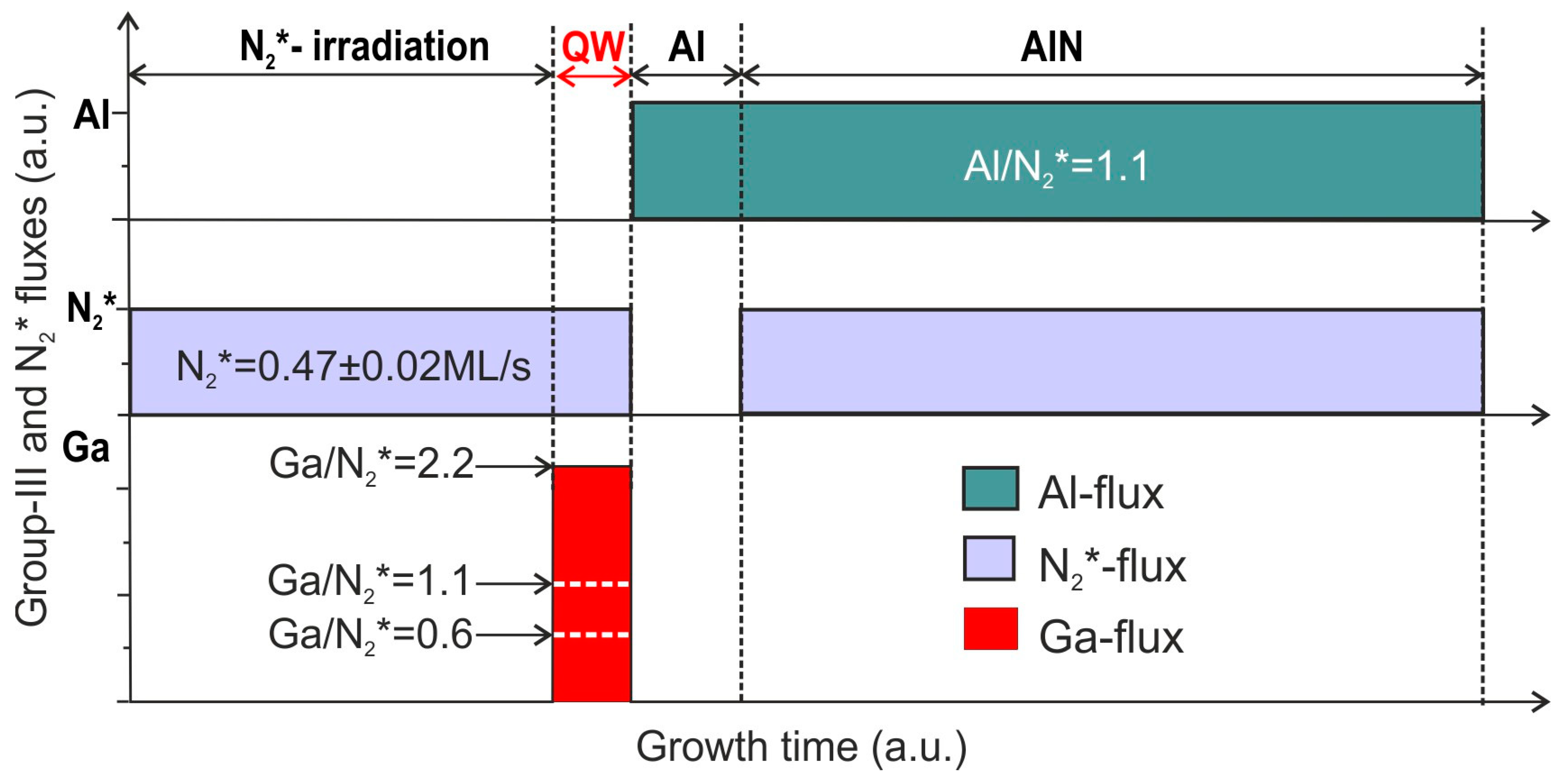
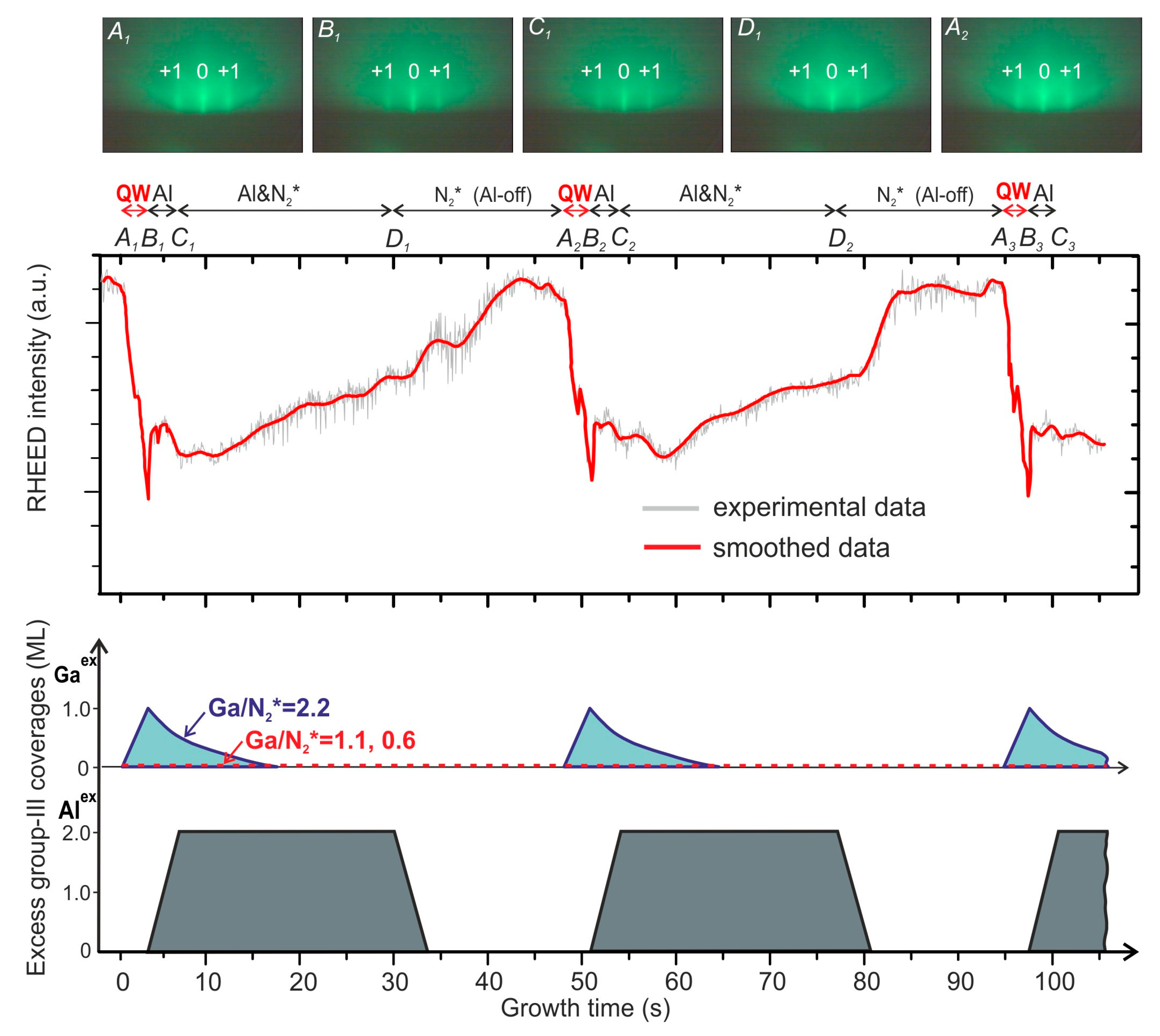
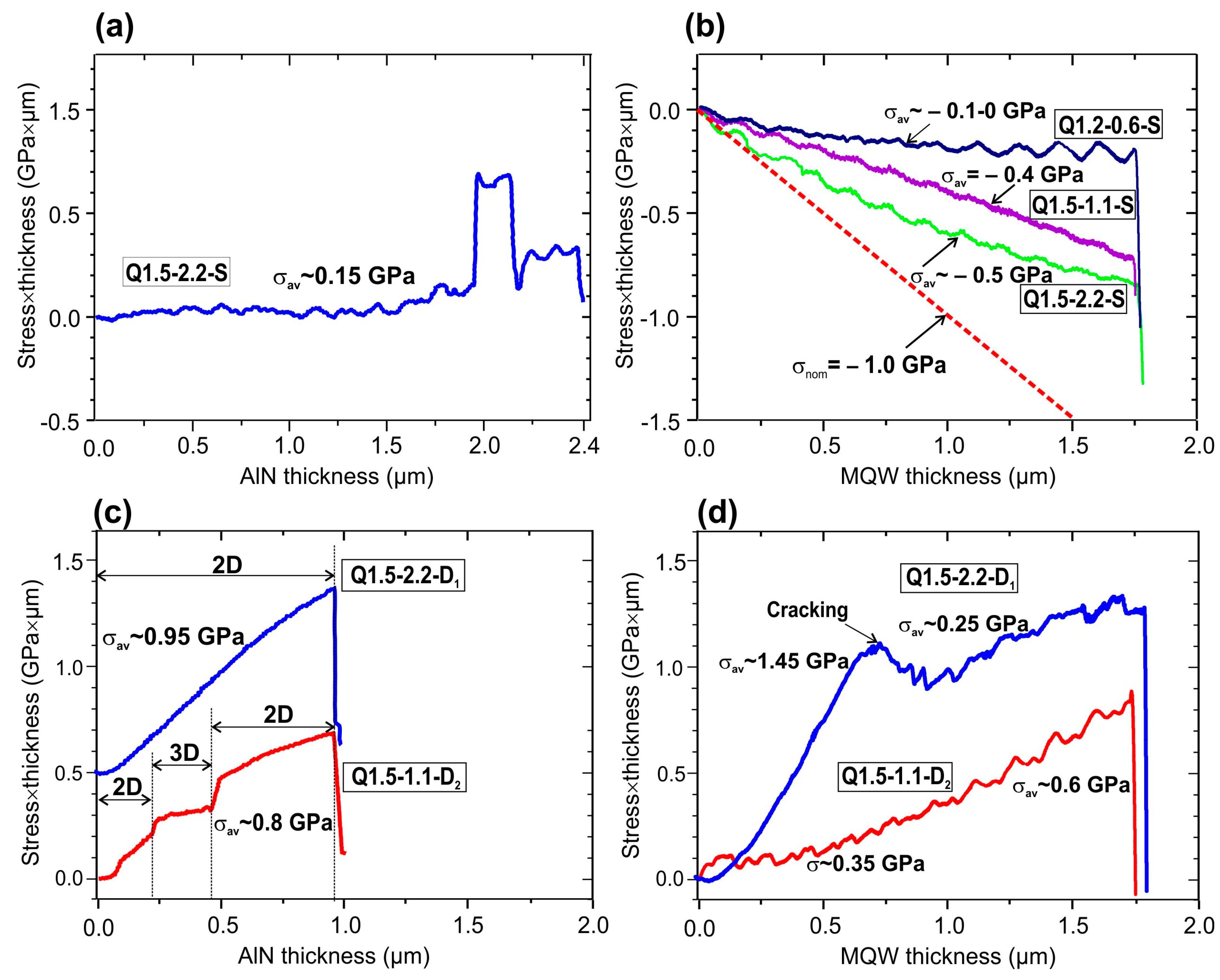
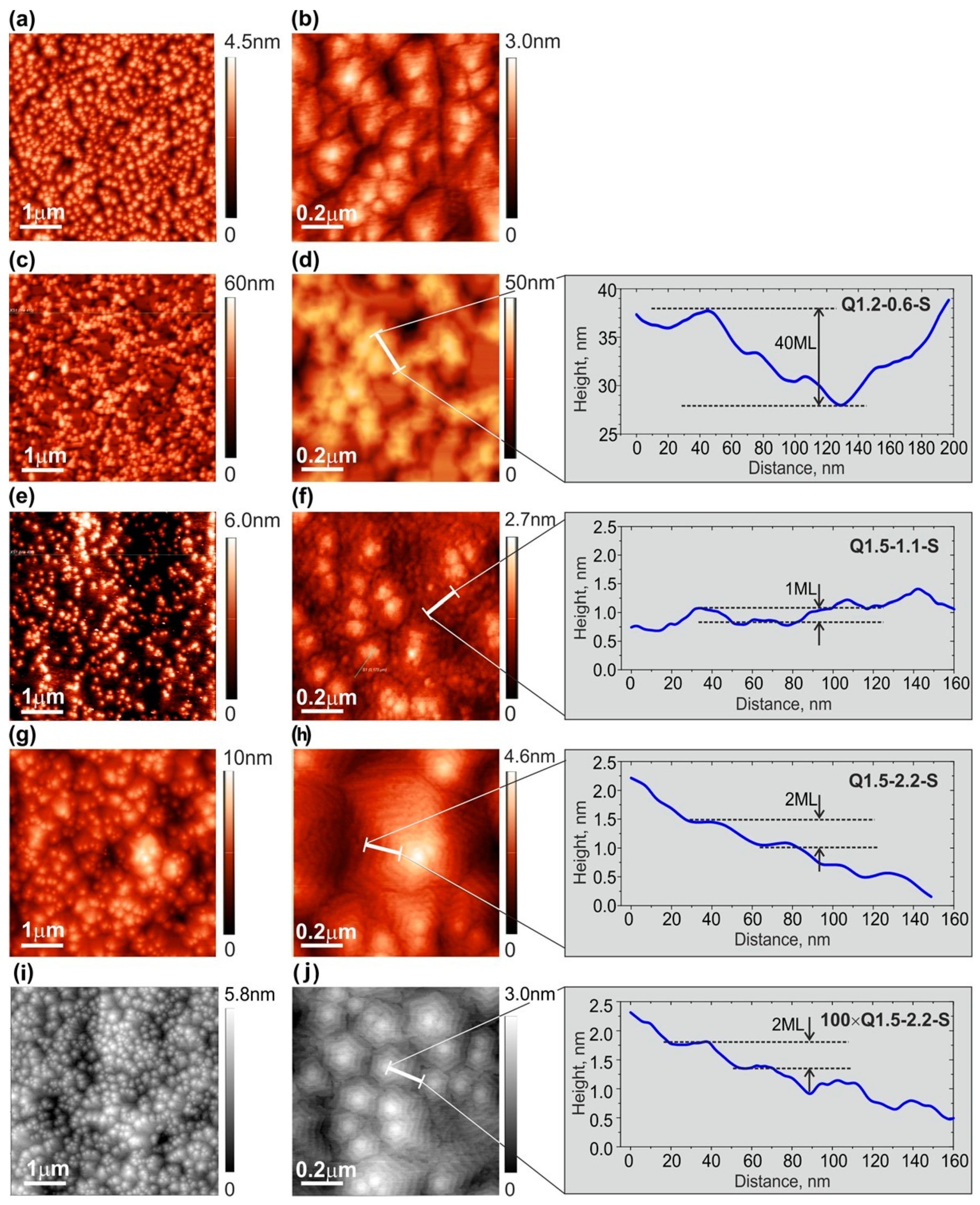
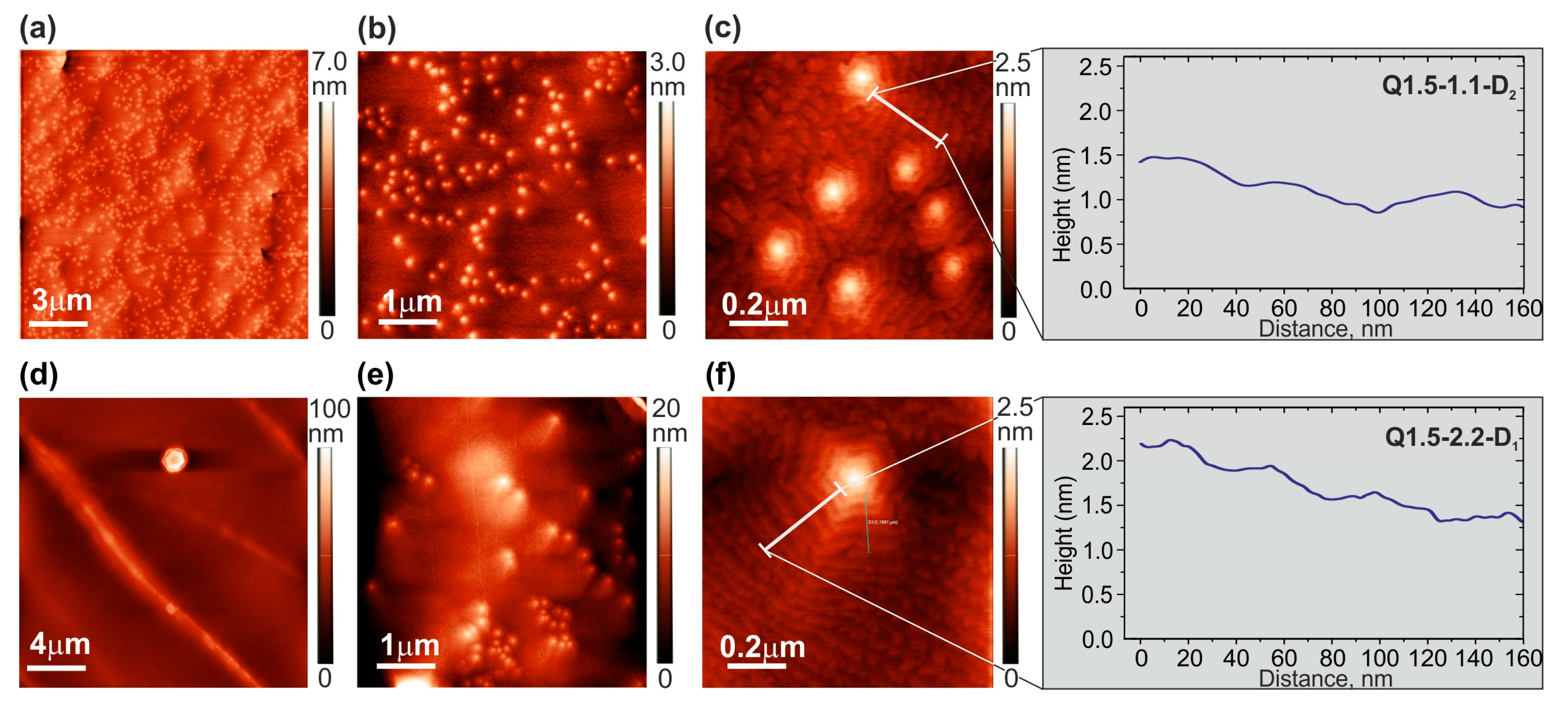
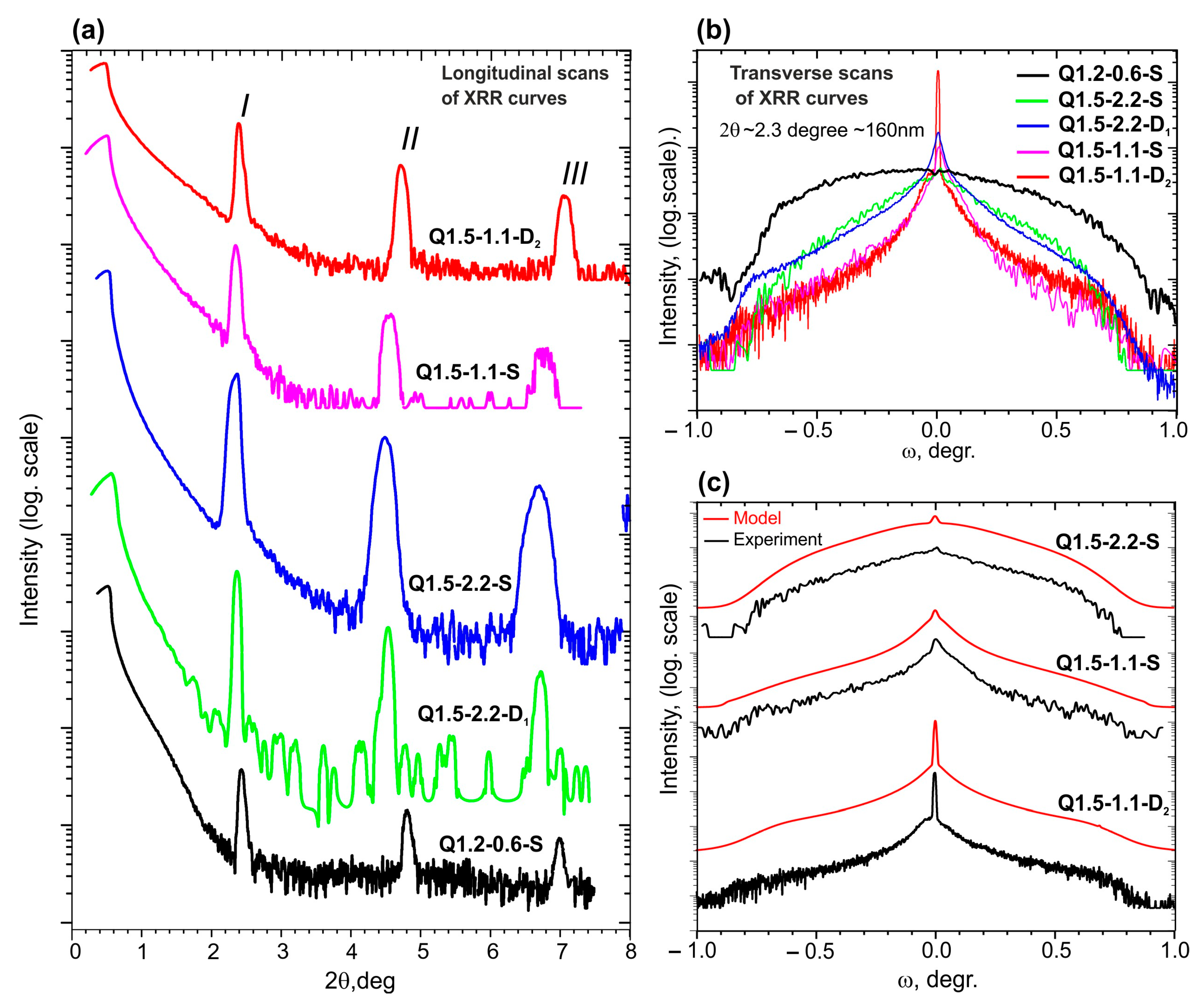



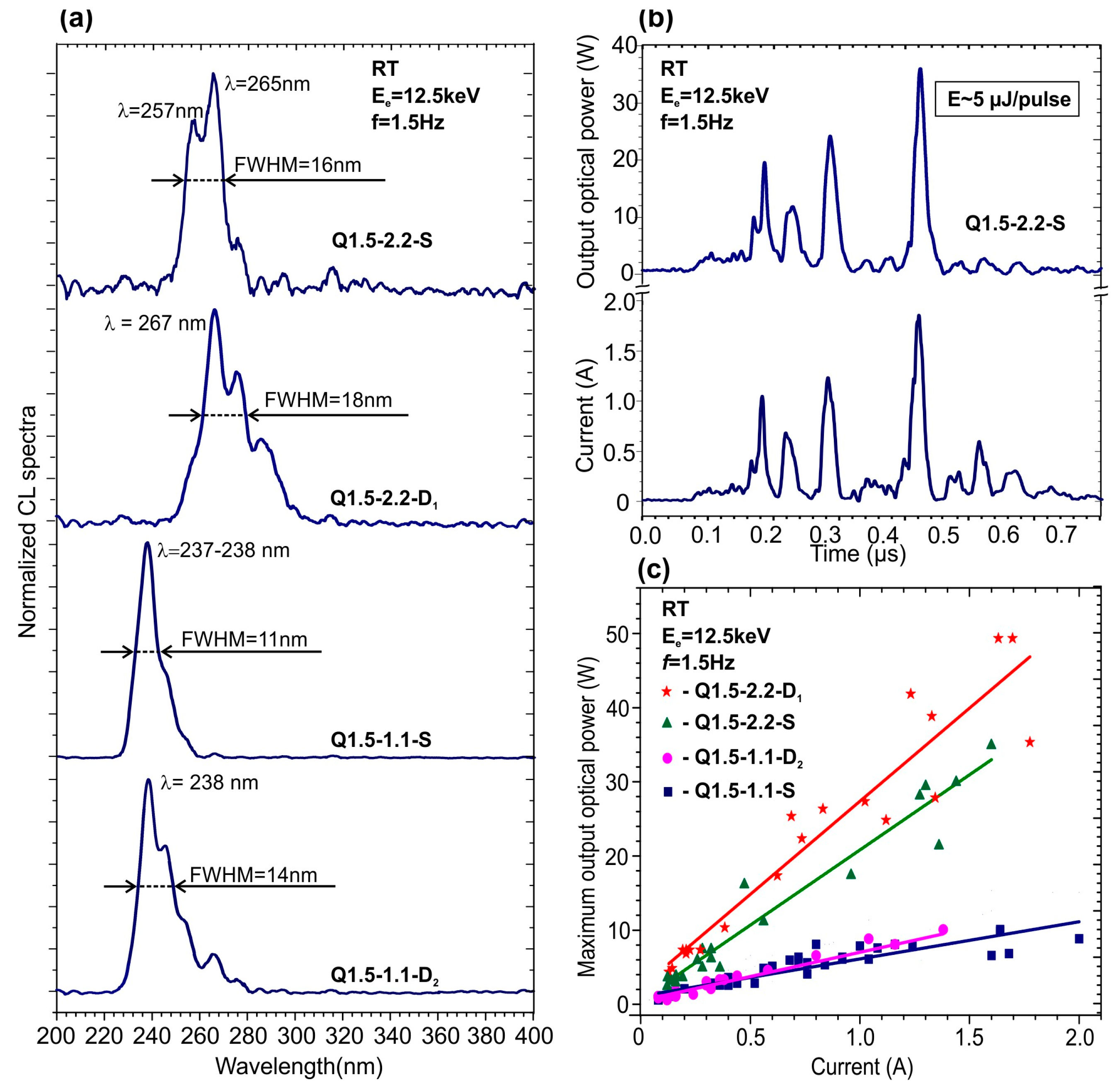
| AlN Test Layer | Q1.2-0.6-S | Q1.5-1.1-S | Q1.5-2.2-S | Q1.5-1.1-D2 | Q1.5-2.2-D1 | |||||||||||||
|---|---|---|---|---|---|---|---|---|---|---|---|---|---|---|---|---|---|---|
| Scanning Area * | Scanning Area | Scanning Area | Scanning Area | Scanning Area | Scanning Area | |||||||||||||
| A | B | C | A | B | C | A | B | C | A | B | C | A | B | C | A | B | C | |
| RMS, nm | 0.54 | 0.59 | 0.43 | 8.1 | 8.2 | 9.3 | 0.57 | 0.51 | 0.35 | 1.27 | 1.27 | 0.79 | 0.51 | 0.34 | 0.31 | 10.2 | 0.67 | 0.20 |
| # Sample | Average Al Content, | MQW Period | RMS Surface | ||
|---|---|---|---|---|---|
| Mol.% | nm | nm | |||
| Nominal | XRD | Nominal | XRR | XRR | |
| Q1.2-0.6-S | 93.0 | 98.6 | 4.269 | 3.69 ± 0.3 | >>1.0 |
| 100 × Q1.5-2.2-S | 91.1 | 93.9 | 4.373 | 4.30 ± 0.12 | 1.1 |
| Q1.5-2.2-S | 91.1 | 96.5 | 4.373 | 4.00 ± 0.08 | 0.8 |
| Q1.5-1.1-S | 91.1 | 96.9 | 4.373 | 4.267 ± 0.04 | 0.6 |
| Q1.5-2.2-D1 | 91.1 | 96.1 | 4.373 | 4.179 ± 0.035 | 0.5 |
| Q1.5-1.1-D2 | 91.1 | 96.1 | 4.373 | 3.894 ± 0.008 | 0.3 |
| № Sample | Roughness Total * | Correlation Lengths | Hurst Parameter | |
|---|---|---|---|---|
| Lateral | Vertical | |||
| nm | nm | nm | ||
| Q1.5-1.1-D2 | 0.3 | >200 | - | 0.3 |
| Q1.5-1.1-S | 0.6 | >200 | - | 0.6 |
| Q1.5-2.2-S | 0.8 | >100 | 4.0 | 1.0 |
Disclaimer/Publisher’s Note: The statements, opinions and data contained in all publications are solely those of the individual author(s) and contributor(s) and not of MDPI and/or the editor(s). MDPI and/or the editor(s) disclaim responsibility for any injury to people or property resulting from any ideas, methods, instructions or products referred to in the content. |
© 2023 by the authors. Licensee MDPI, Basel, Switzerland. This article is an open access article distributed under the terms and conditions of the Creative Commons Attribution (CC BY) license (https://creativecommons.org/licenses/by/4.0/).
Share and Cite
Jmerik, V.; Nechaev, D.; Semenov, A.; Evropeitsev, E.; Shubina, T.; Toropov, A.; Yagovkina, M.; Alekseev, P.; Borodin, B.; Orekhova, K.; et al. 2D-GaN/AlN Multiple Quantum Disks/Quantum Well Heterostructures for High-Power Electron-Beam Pumped UVC Emitters. Nanomaterials 2023, 13, 1077. https://doi.org/10.3390/nano13061077
Jmerik V, Nechaev D, Semenov A, Evropeitsev E, Shubina T, Toropov A, Yagovkina M, Alekseev P, Borodin B, Orekhova K, et al. 2D-GaN/AlN Multiple Quantum Disks/Quantum Well Heterostructures for High-Power Electron-Beam Pumped UVC Emitters. Nanomaterials. 2023; 13(6):1077. https://doi.org/10.3390/nano13061077
Chicago/Turabian StyleJmerik, Valentin, Dmitrii Nechaev, Alexey Semenov, Eugenii Evropeitsev, Tatiana Shubina, Alexey Toropov, Maria Yagovkina, Prokhor Alekseev, Bogdan Borodin, Kseniya Orekhova, and et al. 2023. "2D-GaN/AlN Multiple Quantum Disks/Quantum Well Heterostructures for High-Power Electron-Beam Pumped UVC Emitters" Nanomaterials 13, no. 6: 1077. https://doi.org/10.3390/nano13061077
APA StyleJmerik, V., Nechaev, D., Semenov, A., Evropeitsev, E., Shubina, T., Toropov, A., Yagovkina, M., Alekseev, P., Borodin, B., Orekhova, K., Kozlovsky, V., Zverev, M., Gamov, N., Wang, T., Wang, X., Pristovsek, M., Amano, H., & Ivanov, S. (2023). 2D-GaN/AlN Multiple Quantum Disks/Quantum Well Heterostructures for High-Power Electron-Beam Pumped UVC Emitters. Nanomaterials, 13(6), 1077. https://doi.org/10.3390/nano13061077







